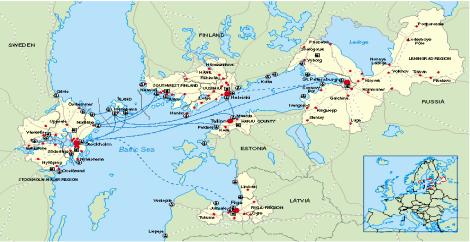|
|
|
3.2 Urban system
VASAB Task (Stockholm Ministerial Conference):
Prepare a programme on balanced urban network development, together with UBC and towns and cities
Limited knowledge is available on the functioning of cities in the BSR, on their role in regional and national development, changes to be expected in the framework of globalisation, transition and integration, and deficiencies as a system to be tackled by spatial policies.
VASAB/ InterregIIC project: USUN
To provide such knowledge, a VASAB project was created (USUN - Urban Systems and Urban Networking in the BSR). Funding was provided within the framework of the InterregIIC programme, and by participating countries.
Results of the project will be:
- an identification of bottlenecks, within the urban system, for regional development;
- proposals for urban networking in the BSR to support balanced spatial development.
The project approach is based on research (by a network of institutes) and on a dialogue with key decision makers. This dialogue concentrates on prospects for urban networking and on spatial development strategies - in particular regarding natural and cultural heritage and tourism.
Key issues analysed include:
- Economic integration: current and potential future trade and investment patterns.
- Urban system: national and pan-Baltic urban systems.
- Urban networking regarding industry, tourism, higher education, sea transport.
The project will be completed in late 2001. But an overview of the present urban systems in BSR countries and of related change trends has been presented 29.First policy conclusions have been suggested30 :
Reciprocity in east-west relations needs to be enhanced: eastern universities tend to form more integrative bilateral agreements than western ones. FDI shows no reciprocity. Trade between east and west BSR is dominated by inter-industry rather than intra-industry trade. Mutual learning east-west and west-east as regards urban policies is also not sufficiently developed. Growth needs to be spread from metropolises to other urban regions. Sub-regional networking shall be promoted to make sub-regions competitive. Industrial co-operation between minor cities needs to be enhanced. New occupations need to be developed for rural populations which, to a large extent, will be in cities.
The project has contributed to the understanding of the importance of urban issues. It has underlined the relevance of city co-operation networks. It has helped to strengthen exchange of views and approaches of research institutes specialised in this subject, which may lead to new insights and improved policy advice.
An important field of urban networking is the exchange of experience on issues such as sub-urbanisation, enhancing public transport, reducing motorised traffic, recycling of urban areas, social segregation, promoting knowledge and innovation, and others.
Other InterregIIC projects concerning urban development and urban networking
Various InterregIIC projects have been started in this field:
InterregIIC project:
Baltic Palette
Baltic Palette deals with the Central Baltic Sea Region (CBSR), comprising the urban regions dominated by Stockholm (Sweden), Helsinki (Finland), St. Petersburg (Russia), Tallinn (Estonia) and Riga (Latvia).
For this strategic integration zone which may become an important BSR sub-region, a cross sector strategic perspective for economic, social, cultural, environmental, and spatial development has been sought. A functioning, interdependent urban system among partner regions and within each of them shall contribute to achieve political and social stability.
The project addresses a broad range of issues, including metropolitan networks, multi-core (decentralised) urban structures, urban management, public transports, information society, coastal zones and tourism.
The project led to the establishment of lasting co-operation networks, for example, between R&D and universities and between metropolitan regions. A joint action programme has been adopted, and organisational structures for its implementation have been set up.
The Baltic Palette co-operation has a good perspective to be sustainable. Its particular strength has been derived from an intensive participation process involving a large number of actors in all participating regions, where each partner sees a benefit from the co-operation.
|
The Baltic Palette Area
|

|
Urban networking and urban development
Conclusions
Urban networking is among the priorities identified by the ESDP.
Operational approaches for urban networking across borders are missing. The VASAB project USUN will make an important contribution to enhanced knowledge. This shall be followed by concrete co-operation projects of cities.
The need continues to exist for experience exchange networks. Important issues for transnational co-operation and experience exchange are for example: transport planning in relation to urban structures, strengthening of knowledge and innovation as competitive tool, impacts of the 'new economy' on urban development, cultural heritage promotion in cities, limitation of urban sprawl, avoidance of social segregation, land recycling and rural-urban partnership.
|
InterregIIC project:
Waterfront Urban Development
This project seeks ways to mobilise derelict waterfront areas (former harbour, industry, military and similar uses) for urban development. This is an important issue for most coastal cities in the BSR.
A number of pilot planning projects are carried out in German, Danish, Swedish, Polish, Finnish and Russian partner cities. The project focus is on an exchange of experience and the preparation of a manual to document development approaches under different situations. InterregIIC project:
Baltic Rim Network
This project seeks to promote networking between enterprises or institutions to support small and medium-sized enterprises (SME) in the BSR.
The project develops a 'Baltic Market Place'. For this purpose, a shared database is established to make offers and requests of SME known to other enterprises.
Partners from Germany, Denmark, Estonia, Lithuania, Finland and Poland represent local authorities and economic and technology promotion centres.
This project deals with urban networking. Bit it differs from other InterregIIC projects in that it is very closely linked to business development. InterregIIC project:
SUPERBS
SUPERBS deals with sustainable urban patterns. A focus is on the revitalisation of old urban areas and on the development of new urban areas. The project seeks to provide knowledge on good examples, and to adapt curricula for students.
Project partners are cities and municipalities from Finland, Sweden, Germany, Estonia, Latvia, Lithuania and Poland. They also include a university from Sweden.
|
|
|

